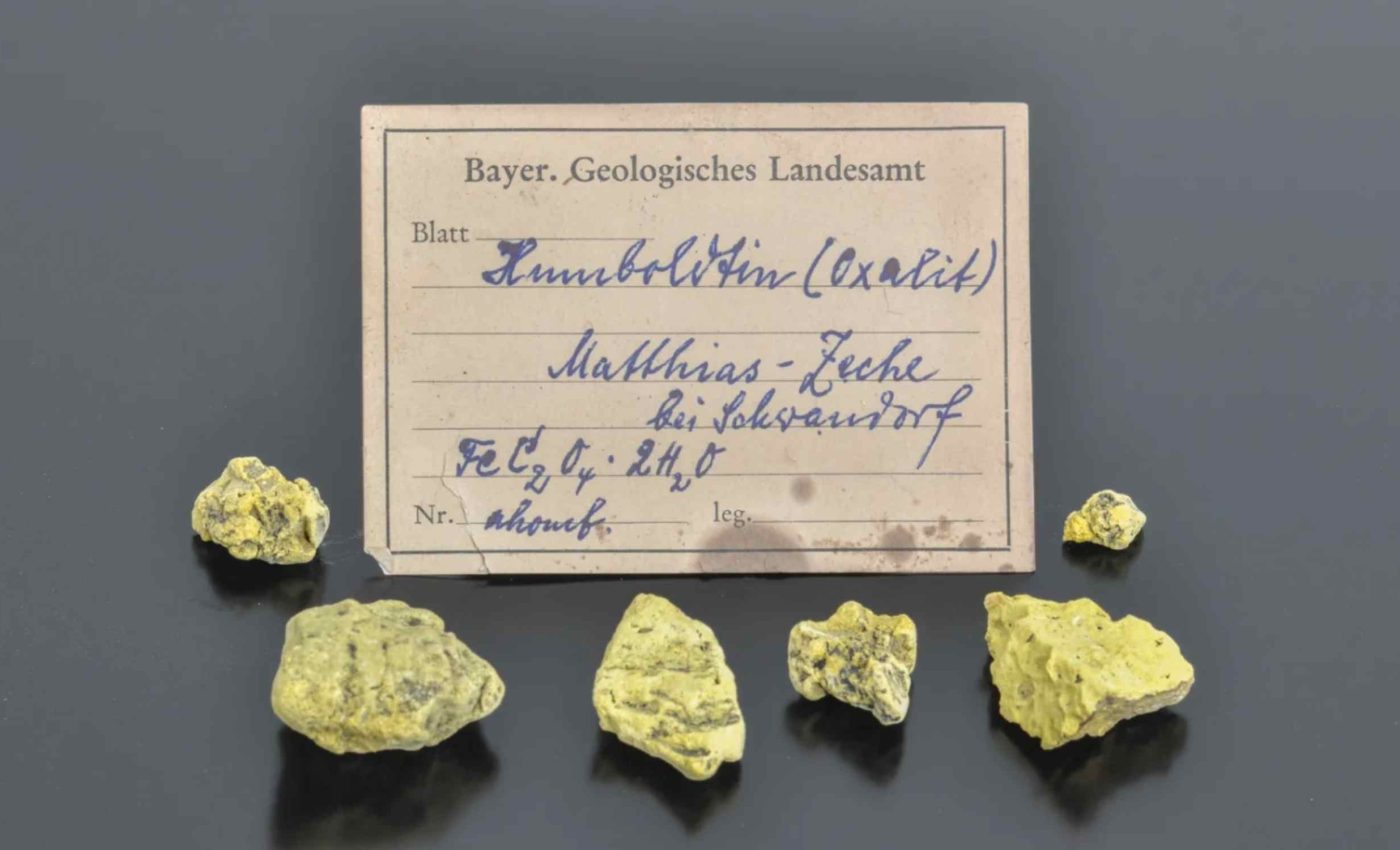
Letter lost for 75 years leads to the accidental discovery of one of Earth's rarest minerals
A dusty envelope misplaced in a government archive has rewritten a chapter of mineral history. That 1949 letter, discovered during a 2023 digitization project in Bavaria, pointed curators toward a shoebox of lemon‑yellow fragments that had sat unnoticed for decades.
Roland Eichhorn of the Bavarian State Office for the Environment (LfU) led the modern hunt that followed, and his team soon realized they were staring at humboldtine, one of the scarcest minerals on the planet.
Humboldtine treasure hunt
Archivists scanning shelves in Hof found the coal‑mine owner’s note and the tantalizing phrase: “Humboldtine from the Mathias mine near Schwandorf.”
Their curiosity sent Eichhorn’s crew rifling through more than 130,000 catalogued specimens stored beneath the LfU headquarters.
In a small box, the team found hazelnut‑sized yellow fragments and a handwritten label that matched the location mentioned in the letter.
With the tag confirmed as authentic, Eichhorn and his team began a full investigation to determine if the samples were truly humboldtine.
What makes humboldtine special
The mineral is an organic mineral, a rare class whose crystal lattice holds carbon, hydrogen, and oxygen bound to metals.
Humboldtine’s formula couples iron with oxalate, giving it a soft hardness of 1.5-2 and a resinous yellow sheen.
Collectors prize it because it has been documented at only 30 localities worldwide, scattered across eight countries.
Each discovery of the mineral seems like a fluke, happening when iron-rich rocks come into contact with certain natural acids in just the right damp conditions.
The mineral first surfaced in 1821, when Peruvian geologist Mariano de Rivero named it for the Prussian explorer Alexander von Humboldt.
Historians count roughly 400 species and minerals that now bear Humboldt’s name, more than for any other individual in science.
Bavarian brown coal
The Bavarian nodules formed about eight feet below ground in a lignite seam that was mined during the mid‑20th century.
Brown coal is not an obvious birthplace for iron oxalate crystals. The reason these yellow nodules formed in the Schwandorf brown coal is still unknown and will likely never be fully understood.
Mining ended years ago, leaving no fresh outcrops to analyze, yet the rediscovered lumps instantly doubled Germany’s documented reserve of the mineral.
Their size, each roughly the volume of a hazelnut, also dwarfs the millimeter‑scale grains typically reported from other sites.
Proving it’s humboldtine
Back at the LfU laboratory, technicians ground a sliver and ran X‑ray diffraction on the powder. The diffractogram matched monoclinic humboldtine with textbook precision, ending any doubts raised by the old label.
Another test showed the sample had the right mix of iron, carbon, oxygen, and water. Since it didn’t contain manganese, it couldn’t be mistaken for a similar mineral called lindbergite.
“We are legally obligated to make geological collection pieces accessible to the public,” noted Eichhorn once the verdict came in. The verified samples will soon be displayed in the agency’s public gallery.
From museum drawer to lab
Beyond curiosity, humboldtine interests materials scientists because iron oxalates can shuttle electrons efficiently.
A 2019 study showed that a related oxalate compound stores charge through both iron and oxalate redox reactions, pointing to safer, high‑capacity cathodes for lithium‑ion batteries.
The 2021 paper by Paula Vehmaanperä and colleagues went further, describing how humboldtine precipitates when oxalic acid dissolves hematite at modest temperatures, suggesting a low‑energy synthesis route.
Engineers now eye the mineral as a precursor for iron‑based battery anodes that avoid cobalt and nickel supply risks.
Those industrial dreams hinge on reliable feedstocks, yet natural humboldtine remains vanishingly scarce. The Bavarian trove shows that museum drawers, not just mines, may hold the key to scaling future green technologies.
Humboldt’s legacy in modern science
The mineral’s namesake, Alexander von Humboldt, wasn’t just a collector, he shaped the way we understand Earth’s interconnected systems.
His approach to mapping botanical zones by climate and geography laid the foundation for modern environmental science.
Humboldt’s influence stretches from volcanology to climate research.
By naming humboldtine after him, scientists honored a thinker whose curiosity bridged minerals, organisms, and entire ecosystems, an approach still shaping how today’s researchers connect geology with global change.
Why catalogues still matter
Digitising legacy collections can expose overlooked pages, mislabelled crates, and minerals that vanished from the field generations ago.
The Schwandorf find underscores how systematic record‑keeping lets modern analysts revisit twentieth‑century fieldwork with twenty‑first-century tools.
As more agencies move their paper files online, Eichhorn predicts further surprises. Somewhere, another scribbled label may be waiting to reveal the next rare crystal, or the next leap for battery science.
The study is published in Clays and Clay Minerals.
—–
Like what you read? Subscribe to our newsletter for engaging articles, exclusive content, and the latest updates.
Check us out on EarthSnap, a free app brought to you by Eric Ralls and Earth.com.
—–













